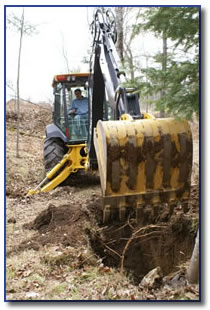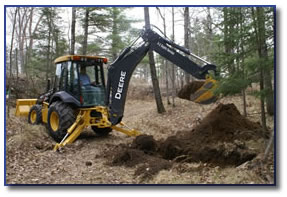|
Soil Testing
Site & Soil Evaluation (Soil Test)  Soil testing is the method used to determine if a site has suitable soil to support a private on-site wastewater treatment system (POWTS), otherwise known as a septic system. The soil must be able to absorb all wastewater derived from ordinary living conditions such as toilets, sinks, dishwashers, laundry facilities, etc. Wisconsin law states that a certified soil tester (CST) must perform this test. Soil testing is the method used to determine if a site has suitable soil to support a private on-site wastewater treatment system (POWTS), otherwise known as a septic system. The soil must be able to absorb all wastewater derived from ordinary living conditions such as toilets, sinks, dishwashers, laundry facilities, etc. Wisconsin law states that a certified soil tester (CST) must perform this test.Previously called a perc test, water was actually poured into holes in the ground for the purpose of measuring just how far into the ground a certain amount of water would go in a certain amount of time, thus determining the percolation rate. This method is no longer used in the state of Wisconsin. Today, a soil test or site and soil evaluation consists of digging a minimum of three pits with a backhoe. The soil tester will enter each pit to evaluate the soil by identifying each horizon in the soil profiles. He will determine the depth of horizons, the types of soil, the structure, consistency of the soil, locate the boundaries of horizons, and detect the presence of root structure.  The pits are typically dug 8' deep or until a limiting factor in the soil is reached, for example water or redoximorfic features. Your septic system must be installed within the soil-tested area. The pits are typically dug 8' deep or until a limiting factor in the soil is reached, for example water or redoximorfic features. Your septic system must be installed within the soil-tested area.The results of the site and soil evaluation will determine the type, design, and size of the septic system. The completed soil test is filed with the county planning and zoning department. Before purchasing a vacant property you should have a soil test completed to determine what type of system can be installed. A soil test and sanitary permit must be on file with the county before a building permit can be issued. A soil test is also required when replacing an existing septic system where an alternate site has not been previously determined. |